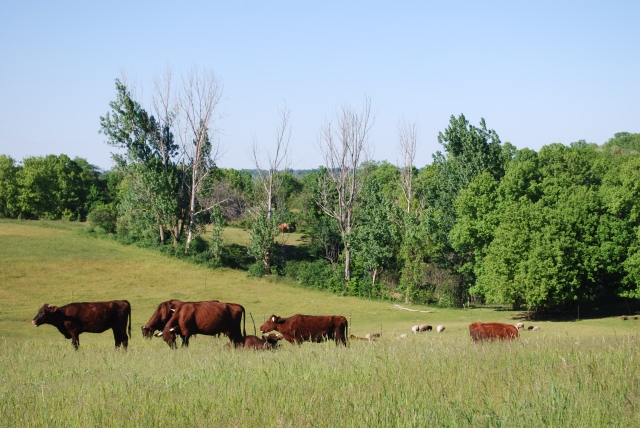
The 11 garlic beds planted with garlic and ready to be mulched.

Another view of the garlic plantings.
Today, October 22, we finally finished the garlic planting. Many thanks to all who have helped us get the garlic planted over the past week; Aliki, Mihaela, Marc, Diane, Laurel, Anca, Ron, Ashley and Catherine, planting the garlic and preparing the ground. It was a lot of work, all by hand except for the short time using the tractor to pull the discs. I estimate that the direct carbon footprint was, very approximately, about 20 pounds of CO2 produced. It would be nice to have this tractor, and all of our fossil fuel powered vehicles, converted to electrical power. But fossil fuel use in our tractors is much less than that used in our personal vehicles, our car and SUV as well as all our other greenhouse gas emitting activities. We need to start using the horses again. For some work that takes enough time to warrant the time spent getting the horses harnessed and unharnessed. A job requiring the horses to work for 10 minutes will still need nearly a full hour to get them ready and then return them to the field. Much of our work with the tractor has been that sort of work. So garlic planting and climate change are linked!

The horses must figure this to be ideal. Cool enough to keep the flies away, no wind and a nice warm morning sun.

Russian garlic is one of the 11 garlic varieties we have planted. It is a smaller garlic with easily broken heads and easily peeled cloves.
The garlic planting this fall is the largest we have done. The planted area is about 4400 square feet, containing 11 beds of garlic with three rows per bed, each row 100 feet long. The garlic cloves are planted at 4 inch spacing in the rows giving 3oo cloves per row, 900 cloves per bed for a total of 9900 (approximately) cloves in the entire garlic planting. It almost seems that we should put in at least one more row to boost our total to over 10, 000 cloves.

The cleaned up manure spreader serving another purpose as a squash wagon prior to becoming a mulch spreader.
The next step is spread leaves over the entire planting, we’ll use the manure spreader behind the tractor for that, more CO2 emissions, then some composted manure and then some woodchips, all with the manure spreader again, and of course more CO2 as well. Too much CO2 and it costs around a buck and a half a litre

The vegetable pickup shed taking on a dual purpose as squash storage.

The shelves really cannot hold any more weight
Today, the 23rd, is ‘pickup squash and pumpkin’ day. We brought in a load yesterday on the spreader (it is a clean spreader right now) and will likely have two more loads today. We need to get it all in as the forecast low for tonight is zero and that will not be good for squash in the field. It took a while but with the 4 of us working, we filled the spreader again with squash and pumpkin and another load was carried and wheelbarrowed in.

The cole crops, kale in the foreground, cabbages, broccoli, cauliflower, brussels sprouts and collards. All growing quite well and like the horses finding autumn weather much suited to them.

The late planted sunflower row is dense and full of bloom and right beside it is the slightly lower sunhemp with it brilliant yellow pea-like flowers

The very last of the sunflower plants. All the rest have flowered and formed seed heads of which the birds have eaten nearly every one. This one grew by itself near the garlic beds which were harvested in July.
The frost overnight and into Sunday morning, the 24th, was light and even some light frost sensitive plants survived. But autumn marches steadily further towards winter and each week sees a slight decrease in temperature along with the shortening length of daylight available. Still much work to be done. The wood burning stove in the house was cleaned and lit for the first time this season and having heat in the house, and a large stove to cook on, is really nice. The woodshed has a new cover. No rain leaking in so our firewood will stay dry. House still needs repairs to be finished before winter, before very long.


































































































































































































































































